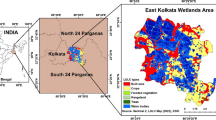Abstract
The over-exploited groundwater resources on the North China Plain have caused ecological problems, including lowering of the groundwater table, enlarging the depression zone and land subsidence. The contingent valuation method, a technique that reveals peoples’ preferences, is applied to measure the in situ value of groundwater in order to provide policy makers information on protection and restoration of groundwater in the region. It was found that only 28% of households were willing to pay some amount of money to preserve ground water. The estimated mean willingness to pay for each household was found to be only 1.26 Yuan/m3 annually. The in situ non-use value of groundwater subject to over-exploitation was estimated to be 0.014 Yuan /m3. These amounts are insignificant when compared to the cost of protecting and restoring the groundwater, which are several hundreds times higher than the estimated willingness to pay. While some discrepancy was expected, the extent of this difference was unexpected. Thus, it would appear that the contingent valuation method does not provide an adequate estimate of the in situ value of groundwater on the North China Plain. It is hypothesized that one reason for this result may be the very low income and education levels of respondents in this area. An integrated economic-ecological modeling technique is recommended as an alternative option to the contingent valuation method in this case.
Similar content being viewed by others
References
Acharya G, Barbier EB (2000) Valuing groundwater recharge through agricultural production in Hadejia–Nguru wetlands in Northern Nigeria. Agric Econ 22:247–259
Barton DN (2002) The transferability of benefit transfer: contingent valuation of water quality improvements in Costa Rica. Ecol Econ 42(2002):147–164
Bi SH (2003) Current situation of overdrawn of groundwater and countermeasures in China. Groundwater 25:72–74 (in Chinese)
Carpenter SR, Gunderson LH (2001) Coping with collapse: ecological and social dynamics in ecosystem management. BioScience 51:451–457
Ciracy-Wantrup SV (1947) Capital returns from soil conservation practices. J Farm Econ 29:1188–1190
Committee on Valuing Groundwater, Water Science and Technology Board, Commission on Geosciences, Environment, and Resources, National Research Council (Simply called as CWCN in the paper) (1997) Valuing ground water economic concepts and approaches. National Academy Press, Washington, DC
Devousges WH, Johnson FR, Dunford RW, Boyle KJ, Hudson SP, Wilson N (1993) Measuring natural resource damage with contingent valuation: tests of validity and reliability. In: Hausman JA (ed) Contingent valuation: a critical assessment. North Holland, Amsterdam, pp 91–159
Dosi C (2001) (ed) Agricultural use of groundwater towards integration between agricultural policy and water resources management. Kluwer, Dordrecht, The Netherlands
Evans RS (2002) A groundwater management strategy for the North China Plain. Balancing the groundwater budget. International Groundwater Conference, Darwin, May 12, 2002. CD-ROM
Fengqiu County’s Agricultural Bureau (2004) Annual report of Agricultural economy in Fengqiu County in 2003 (in Chinese)
Gatto M, De Leo G (2000) Pricing biodiversity and ecosystem services: the never-ending story. Bioscience 50:347–355
Gregory R (1999) Identifying environmental values. In: Dale VH, English MR (eds) Tools to aid environmental decision making. Springer, Berlin Heidelberg New York, pp 32–58
Jorgensen BS, Wilson MA, Heberlein TA (2001) Fairness in the contingent valuation of environmental public goods: attitude toward paying for environmental improvements at two levels of scope. Ecol Econ 30:133–148
Li HJ (2004a) Alleviating water crisis in China by desalting the sea water. http://www.people.com.cn
Li H (2004b) Water price for the Yellow River diversion project. Shanxi Water Resources 2004.6 (In Chinese)
Liu CJ (2003) Solve water crisis in the North China by transferring water from south to north and water saving in north. http://www.hwcc.com.cn (23th, July)
Loomis JB, Walsh RG (1997) Recreation economic decisions: comparing benefits and costs, 2nd ed. Venture Publishing, State College, PA, pp 159–176
Ministry of Agriculture (2000) Tabulation of production cost and return of agricultural products. Ministry of Agriculture, Beijing
Mitchell RC, Carson RT (1989) Using surveys to value public goods: the contingent valuation method. In: Resource for the future, John Hopkins University Press, Washington, DC
Pfaffenberger W, Scheele U (1992) Environmental aspects of water price formation: an empirical investigation of the cost of groundwater protection. Environ Resour Econ 2:323–339
Salman AZ, Al-Karablieh E (2004) Measuring the willingness of farmers to pay for groundwater in the highland areas of Jordan. Agric Water Manag 68:61–76
Shu G, Zhou YX, Zhang MH, Smallwood KS (2001) A sustainable agro-ecological solution to water shortage in the North China Plain (Huabei Plain). J Environ Plan Manag 44:345–355
Stoorvogel JJ, Antle JM, Crissman CC, Bowen W (2004) The tradeoff analysis model: integrated biophysical and economic modeling of agricultural production systems. Agric Syst 80:43–66.1
Venkatachalam L (2004) The contingent valuation method: a review. Environ Impact Asses Rev 24:89–124
Wang SB, Zheng HT, Zhao QQ (2003) SPSS Statistical analysis. China Machine Press, Beijing (in Chinese)
Whittington D (1998) Administering contingent valuation surveys in developing countries. World Dev 26:21–30
Xu ZM, Cheng GD, Zhang ZQ, Su ZY, Loomis J (2003) Applying contingent valuation in China to measure the total economic value of restoring ecosystem services in Ejina region. Ecol Econ 44(2003):345–358
Yang H, Zhang XH, Zehnder JB (2003) Water scarcity, pricing mechanism and institutional reform in northern China irrigated agriculture. Agric Water Manag 61(2003):143–161
Yuci County’s Agricultural Bureau (2004) Annual report of Agricultural economy in Fengqiu County in 2003 (in Chinese)
Yung EC (2004) An ecological perspective on the valuation of ecosystem services. Biol Conserv 120(2004):549–565
Author information
Authors and Affiliations
Corresponding author
Rights and permissions
About this article
Cite this article
Wei, Y., Davidson, B., Chen, D. et al. Can Contingent Valuation be Used to Measure the in Situ Value of Groundwater on the North China Plain?. Water Resour Manage 21, 1735–1749 (2007). https://doi.org/10.1007/s11269-006-9123-2
Received:
Accepted:
Published:
Issue Date:
DOI: https://doi.org/10.1007/s11269-006-9123-2




